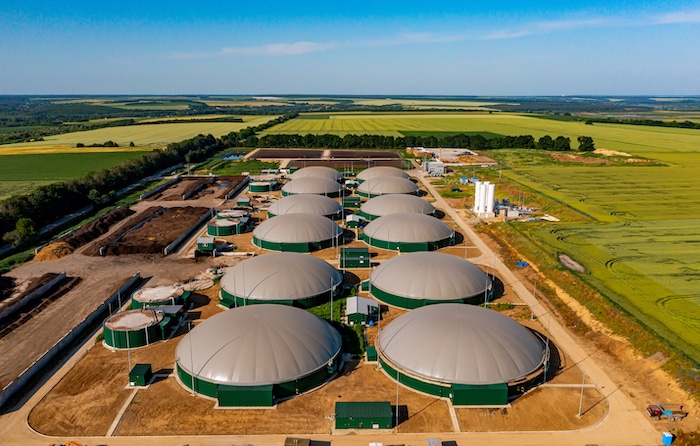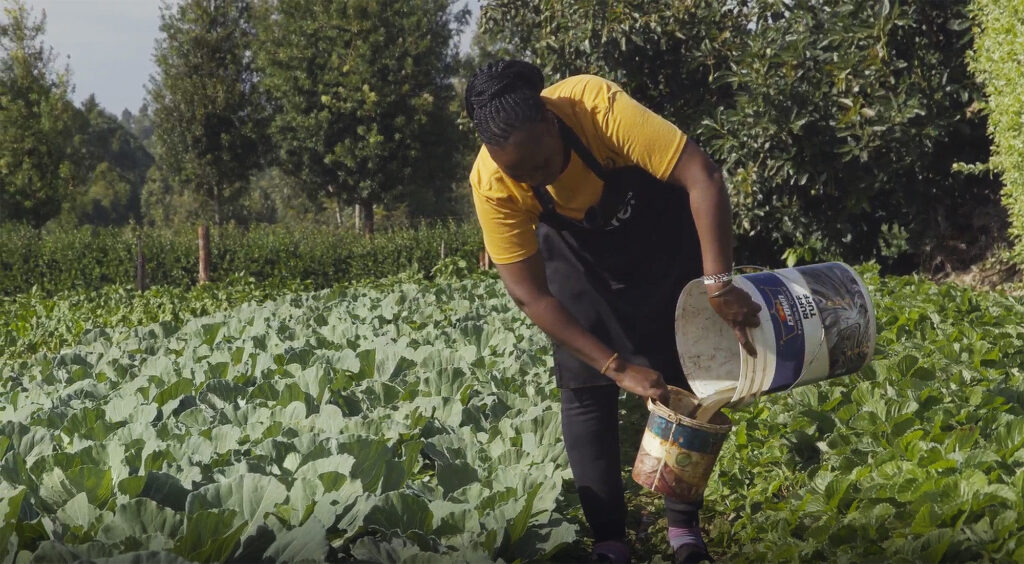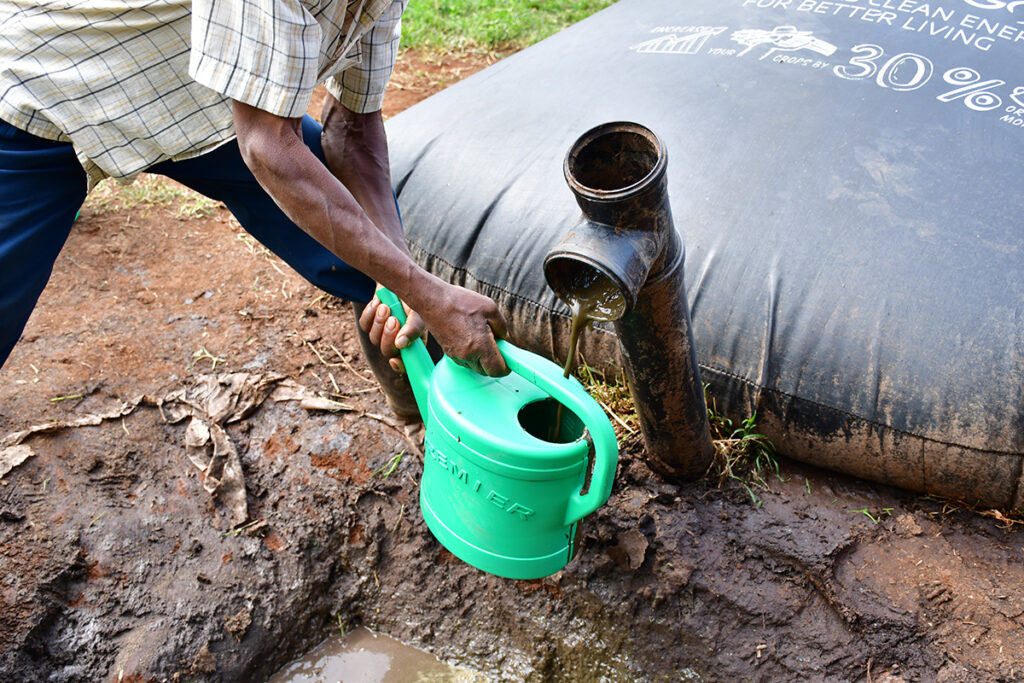
What Is Biomethane?
Biomethane is biogas refined to meet the same quality standards as conventional natural gas. Often called renewable natural gas (RNG) or green gas, it’s a sustainable energy source — the biogas is produced through the anaerobic digestion of organic materials such as agricultural waste, crop residues and animal manure, woody biomass, sewage, food scraps, and other bio-based feedstocks.
The enthusiasm around biomethane is primarily driven by its potential to address multiple environmental and energy-related challenges.
The Differences between Biogas and Biomethane
The key differences between biogas and biomethane are their purity and suitability for various applications.
Biogas is made of methane (CH4), carbon dioxide (CO2), and trace amounts of other gases. It’s primarily suited for on-site energy needs, like heating, cooking, and electricity generation. The advantage is that raw biogas can be used directly from the production source. However, biogas isn’t a suitable alternative to natural gas due to its composition.
Biomethane is a purified and upgraded form of biogas. It undergoes a refinement process to remove carbon dioxide and other contaminants, resulting in a gas with at least 95% methane in its composition. This way, it becomes a high-quality, versatile fuel that can substitute fossil gas for power generation or as a clean vehicle fuel.
Production of Biomethane Explained
Biomethane production starts with biogas produced through the microbial decomposition of organic materials in an oxygen-free environment, a process called anaerobic digestion.
Upgrading biogas to biomethane involves several processes to remove impurities and increase the methane content to 95% or higher.
- The first step in purification is gas cleaning — removing carbon dioxide (CO2) through methods like water scrubbing or chemical absorption.
- Biogas often contains moisture, so the second step focuses on removing water using a drying process, such as passing the gas through a desiccant bed or refrigeration.
- Biogas may also contain hydrogen sulfide (H2S) and other impurities, so the next step aims to eliminate them with iron sponge beds or activated carbon filters.
- After removing impurities, the remaining gas is enriched through purification and upgrading technologies that further increase the methane’s purity.
- The purified and upgraded gas is then compressed to increase its energy density, making it more practical for storage and transportation.
The gas quality is continuously monitored throughout the purification and upgrading process to ensure it meets the required standards for biomethane. This includes checking for methane concentration, residual impurities, and moisture content. Once the gas has been purified and upgraded, it can be directly injected into the natural gas grid, used for electricity generation, or compressed and used as a vehicle fuel.
Biomethane can be produced in a variety of facilities:
- Wastewater treatment plants
- Landfills
- Large farms
- Food processing plants
- Anaerobic digestion facilities
- Energy crops farms
- Biogas plants and biogas upgrading facilities
Environmental Benefits of Biomethane
- Biomethane usage helps reduce greenhouse gas emissions, capturing and using methane that would otherwise be released into the atmosphere.
- Producing biomethane diverts organic matter from landfills, reducing the risk of water, air, and soil pollution.
- Biomethane is a renewable natural gas that reduces the need for fossil fuels.
- Biomethane has a lower carbon footprint than natural gas, as its production and usage release fewer carbon dioxide emissions.
- Biomethane-powered vehicles produce significantly lower greenhouse gas emissions and pollutants than gasoline or diesel, improving air quality.
- Making and using renewable natural gas aligns with the principles of a circular economy by efficiently reducing waste and generating clean energy.
Biomethane Uses and Applications
One application of biomethane is in the transportation sector as a clean and renewable fuel for natural gas vehicles (NGVs), including cars, buses, and trucks.
Biomethane uses also include generating electricity in combined heat and power (CHP) plants, with applications in industrial operations, district heating, and power generation. When combusted in high-efficiency gas boilers or used in absorption chillers, biomethane provides a sustainable and low-carbon alternative to conventional natural gas for climate control systems.
Another vital application of biomethane is its injection into the natural gas grid, where it can be used for a wide range of residential, commercial, and industrial applications. This integration with existing infrastructure increases the biomethane potential as a viable alternative to natural gas, allowing a seamless transition to a cleaner and renewable energy source.
Advantages and Challenges of Biomethane
Biomethane advantages
- It reduces reliance on a single energy source and enhances energy security.
- Biogas production is an environmentally friendly way to manage organic waste.
- Biomethane distribution is easy thanks to its compatibility with existing natural gas infrastructure.
- Biomethane can be produced locally, promoting energy independence.
- The biomethane industry can create jobs in collecting, processing and distributing organic waste and biogas production.
Biomethane disadvantages and challenges
- Limited quantities of suitable feedstock can impact the amounts of biomethane available.
- Competition for organic matter can lead to increased costs and potential conflicts over land use.
- The infrastructure for producing and distributing biogas and biomethane requires significant capital investments.
- The risk of methane leakage during production and distribution could offset overall environmental benefits.
- Regional policies for biomethane and its injection into gas grids vary, slowing adoption at scale.
- The profitability of biomethane plants may depend on government incentives and subsidies.
Global Initiatives and Market Outlook
The global biomethane market was worth $3.1 billion in 2022, and experts estimate its growth to $5.5 billion by 2032. The industry’s future depends on the global energy landscape and multiple variables — from tech innovation to developing better energy policies worldwide.
The European Union continues to lead the world as the largest producer of biogas and biomethane. The United States ranks as the second-largest biomethane producer, emphasizing landfill gas recovery and extensive biomethane upgrades.
In China, national policies encourage domestic biogas production through small digesters, which are excellent for providing a source for heating and cooking in rural areas. Large-scale facilities are under development, too, capitalizing on abundant input materials and high demand for clean energy.
Other global production hotspots include Thailand (utilizing cassava waste), India (focused on municipal waste), Brazil (utilizing landfills), and Argentina (making use of agricultural waste).
Research and Innovation in Biomethane
Research and innovation in biomethane go beyond identifying more efficient and cost-effective methods for biomethane production. Sure, exploring new feedstock sources, optimizing biogas production and gasification, and exploring new feedstock sources are crucial to the industry, but so is standardizing integration into existing gas networks.
Standard rules are needed to ensure that biomethane can seamlessly blend with conventional natural gas to accelerate distribution and adoption at scale. For this to happen, research on effective policy frameworks is necessary. Policymakers need reliable, accurate data to make changes that balance economic viability and sustainability, ensuring that biomethane can compete in the energy market while meeting environmental goals.
Last, research must provide data-driven evidence of biomethane’s positive environmental impact. Community engagement and education on the benefits of shifting from fossil natural gas to biomethane can positively influence public perception and encourage usage worldwide.
Future Prospects
Biomethane is widely recognized as a sustainable alternative to natural gas and can become a pillar for the strategy to reduce carbon dioxide (CO2) emissions and ensure a stable power supply to meet growing demand. With evolving regulations and technological advancements, a robust framework for future growth is in progress.
The International Energy Agency (IEA) predicts two critical scenarios for global energy production and distribution. Biogas and biomethane continue to win market share in both of them thanks to their ability to generate clean energy.
- The “Stated Policies Scenario” (STEPS) uses today’s market and technology data to predict how the industry will develop in the following years. In this case, biogas and biomethane are likely to gain a market share of 12% by 2040.
- The “Sustainable Development Scenario” (SDS) considers ambitious goals aligned with the Paris Agreement’s objectives of limiting global temperature rise. This approach creates more opportunities for biogas and biomethane production, estimating a market share of 20% by 2040.
FAQs:
Is biomethane a renewable gas?
Yes, biomethane is a renewable source of energy thanks to the cyclical nature of its source materials and its capacity to reduce overall carbon emissions. Biomethane comes from biogas from agricultural and food waste, sewage sludge, or sequential crops. These organic sources are replenishable and produce methane when they decompose naturally. Biomethane production captures this methane, preventing its release and significantly reducing greenhouse gas emissions.
Is biomethane better than natural gas?
Biomethane is better for its renewable nature and lower ecological impact, particularly in reducing carbon footprints and transitioning to more sustainable energy sources. However, it may not always fully replace natural gas due to feedstock availability and infrastructure challenges.
Is biomethane a liquid or gas?
Biomethane is in a gaseous state at standard temperature and pressure. However, it can be liquefied to form LBG (liquefied biomethane) through cryogenic upgrading technology or conventional techniques connected to a small-scale liquefaction plant. Another approach involves injecting biogas into the natural gas grid and liquefying a portion at a pressure letdown station. This conversion process into LBG enhances biomethane’s portability and storage capabilities, making it suitable for more applications.
Meet HomeBiogas — Turn Your Waste into Clean Energy
HomeBiogas is a compact anaerobic digestion system designed for residential use. It operates through an eco-friendly process that converts organic waste into biogas and bio-fertilizer.
The magic happens inside the biodigester, available in different sizes to accommodate varying amounts of organic waste. You feed the biodigester with organic waste materials, such as kitchen scraps (vegetable peels, food leftovers), garden waste, or animal manure. Then bacteria get to work, breaking down the organic matter in the absence of oxygen to produce biogas. You can harness the collected biogas for cooking through a gas outlet connected to a biogas stove — included in the HomeBiogas kit.
The HomeBiogas system enables a continuous process, meaning you can keep adding organic waste while it simultaneously produces biogas. It’s a self-sustaining cycle if you regularly provide the system with organic inputs.
In addition to biogas, the biodigester generates a nutrient-rich bio-fertilizer as a byproduct. This organic fertilizer is an excellent soil conditioner and can enhance the fertility and quality of your garden soil or lawn.
Final Thoughts
As long as we produce waste, we generate methane alongside it. Allowing this methane to escape into the atmosphere only deepens the challenges of climate change. The good news is that we have the means and the technology to turn this challenge into an opportunity.
Biomethane as a renewable energy source represents a significant step towards a greener and more sustainable future, aligning with global efforts to reduce greenhouse gas emissions. Innovative solutions like HomeBiogas empower individuals and small businesses to participate actively and make eco-conscious choices. These proactive steps alleviate the impact of waste-related methane emissions and showcase the potential for individuals to be significant contributors to a cleaner and greener world.






